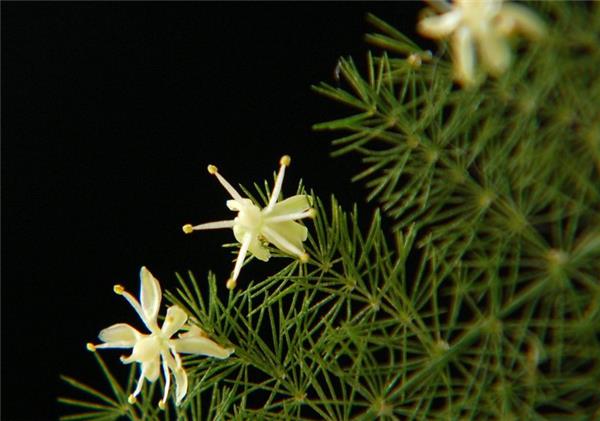Flower friends remind you what to do if asparagus leaves turn yellow.
Asparagus has always been the favorite of scholars, and they also pay more attention to the cultivation of asparagus. But there will still be problems. In the breeding of asparagus, if the leaves turn yellow, how do you deal with them? let's know how to do with the yellow leaves of asparagus.

What if the leaves of asparagus turn yellow
1. The light is too strong
Asparagus is a kind of shade-loving plant, strong light should be avoided in the process of cultivating asparagus, especially in summer, otherwise it is very easy to cause withered and yellow branches and leaves, and it may lead to the death of asparagus if not treated in time.
Solution: when asparagus leaves turn yellow, the flowerpot should be moved to a cool place in time, and water should be often sprinkled on the branches and leaves to increase the humidity of the air and provide a good growing environment for asparagus.
2. Improper fertilization
We all know that if you apply too much fertilizer to plants, it will lead to plant death, and asparagus is no exception. If you apply too much fertilizer or unrotten fertilizer to asparagus, it is very easy to burn roots, which will lead to adverse nutrient absorption. There will be phenomena such as yellowing of leaves, drying up and shedding, but non-fertilization will lead to the lack of sufficient nutrients, and the problem of yellowing of leaves will also occur.
Solution: if there is too much fertilizer, it is recommended to change the pot immediately and transplant asparagus to a new environment; if there is not enough fertilizer, it is recommended to increase the amount of chemical fertilizer to provide the nutrients needed by asparagus.

3. Improper watering
Asparagus is not only a shade-loving plant, but also a wet plant, but asparagus is afraid of waterlogging, and too wet soil will lead to poor breathing in the roots of asparagus, resulting in excessive lactic acid and rotting roots. therefore, it is recommended that asparagus culture should not be watered frequently, and it is not too late for the soil surface to dry.
Solution: pour out the water in the basin and place it in the sun for a period of time so that the water can evaporate as soon as possible. In the aspect of watering asparagus, we must know that more water is easy to rot roots, less water is easy to dry tip, and more water should be sprayed to the leaves in the dry season.
2. Culture methods of asparagus
Asparagus likes warm and ventilated, semi-overcast and semi-humid environment, not cold-resistant, avoid direct sunlight, and is suitable for growing in sandy soil rich in humus and good drainage. The key to asparagus cultivation is watering. Too much watering, basin soil is too wet, easy to cause root rot and yellow leaves fall off: too little watering, basin soil is too dry, it is easy to lead to leaf tip yellowing, scorch shedding. Therefore, usually watering depends on the weather, growth, and basin soil conditions, correctly do not dry do not water, watering thoroughly, not "half of the water", that is, watering only wet soil surface, the lower basin soil is still dry. When asparagus is hot and dry, it is necessary to spray its leaves with water to increase humidity and cool down. Less watering should be done in winter, and room temperature should be kept above 5 degrees. Asparagus is afraid of smoke and dust, so the place should be ventilated.

3. Hydroponic culture of asparagus
1. Take out asparagus in about two months to see if there are white new roots. Generally, if you do not continue to cultivate them, if you have new roots, you can take them out. After washing the roots, you can transplant them into a container with a hydroponic basket. The hydroponic container can be translucent, which can prevent the damage of strong light to the root.
2. Pebbles or ceramsite can be added to the water culture basket to fix the plant. When fixed, let the roots fully stretch; then soak the roots in a 1 ‰ carbendazim solution together with the planting basket for 30 minutes, put them in a cool place, and then proceed to the next step after the roots become soft.
3. It takes two or three days to change water in the initial stage of hydroponics, and four or five days after half a month. Depending on the weather, if the temperature is high, water will be changed frequently. If the temperature is low, the water will be changed less. The amount of water added is usually half or 1/3 of that of the root.
4. the nutrient solution of hydroponic asparagus should be special for asparagus. Spray water to the leaves twice a day, under the condition of 15 Mel 25 ℃, new roots can grow in two weeks, and foliar fertilizer should be added every other week.
5. Because asparagus prefers a semi-humid environment, it is usually placed near a window with light, but where the sun cannot shine directly, and keep it ventilated. Put a tray with water under the container and replenish it frequently.

The above put forward some solutions to the yellowing of leaves that often occur in the process of asparagus culture. I hope it can be helpful in your asparagus culture and play a good embellishment role in the home environment.
Hope to be helpful in your asparagus culture and play a good embellishment role in the home environment.
Related
- Wuhan Hospital Iron Tree Blooming Result Was Instantly Frightened by the Gardener Master
- Which variety of camellia is the most fragrant and best? Which one do you like best?
- What is the small blue coat, the breeding methods and matters needing attention of the succulent plant
- Dormancy time and maintenance management of succulent plants during dormancy
- Minas succulent how to raise, Minas succulent plant pictures
- What are the varieties of winter succulent plants
- How to raise succulent plants in twelve rolls? let's take a look at some experience of breeding twelve rolls.
- Attention should be paid to water control for succulent plants during dormant period (winter and summer)
- Watering experience of twelve rolls of succulent plants
- Techniques for fertilizing succulent plants. An article will let you know how to fertilize succulent plants.



